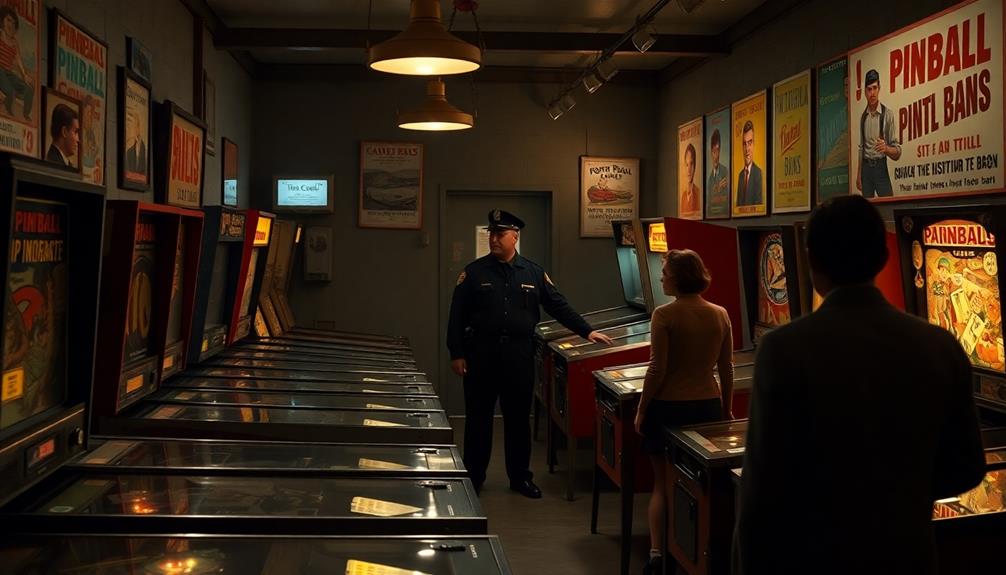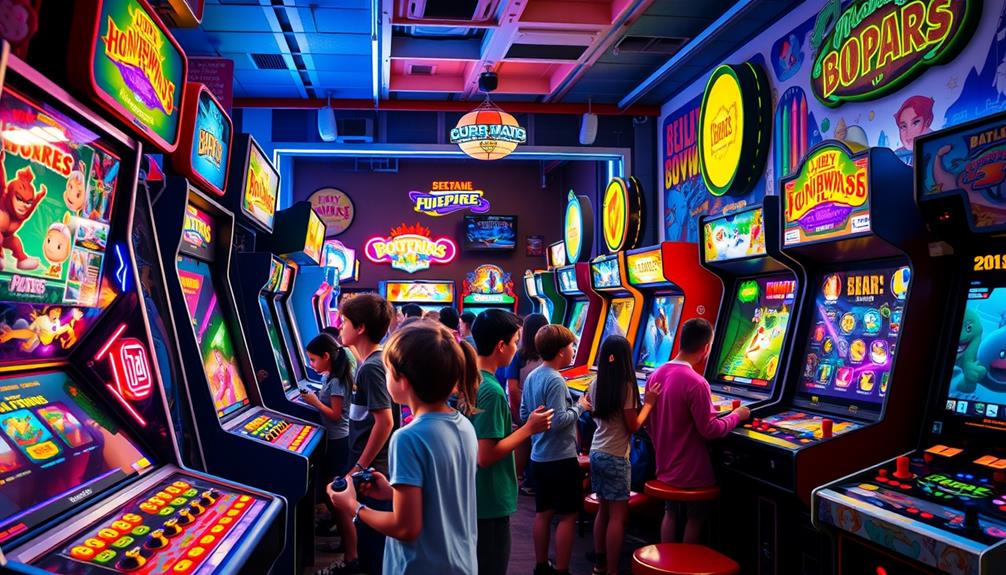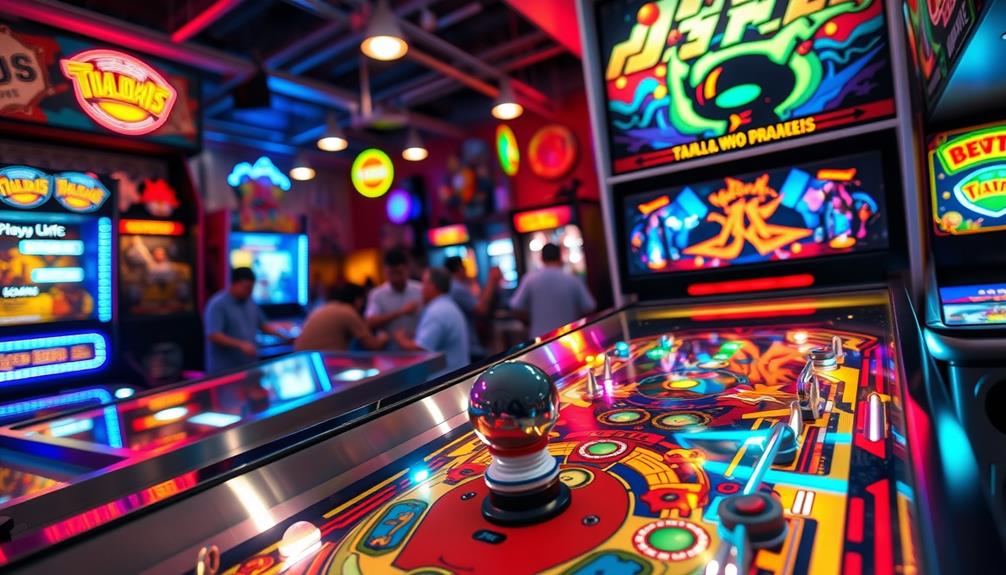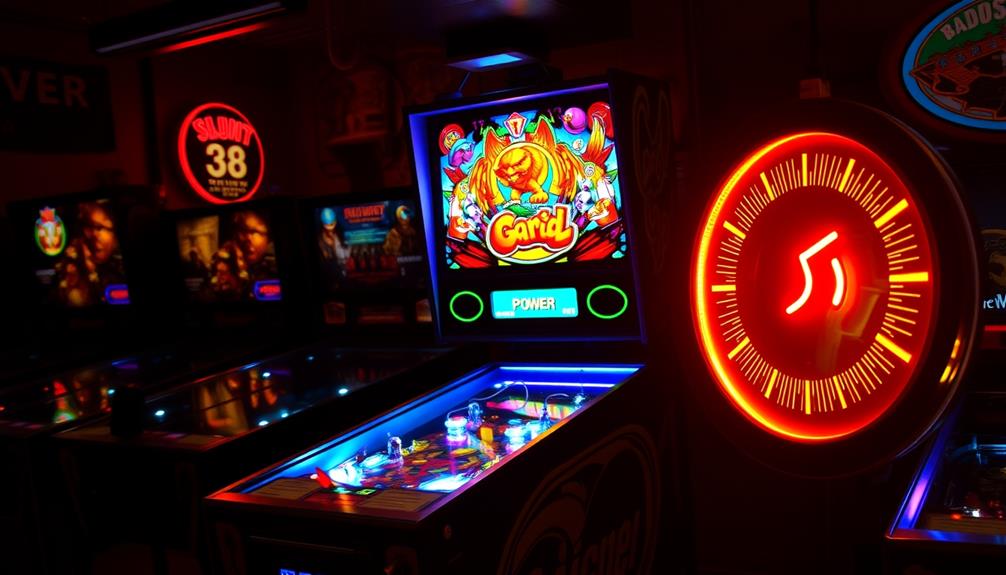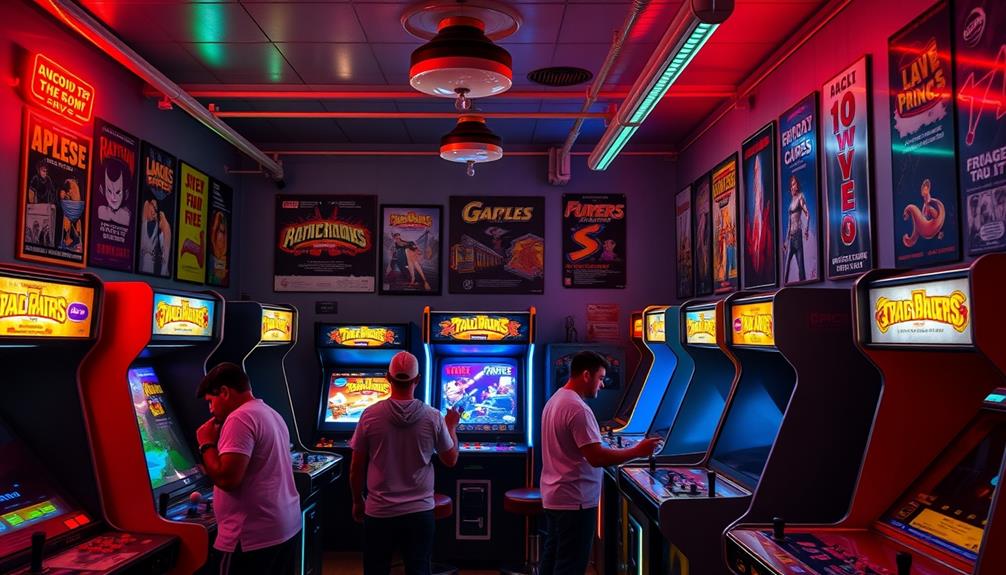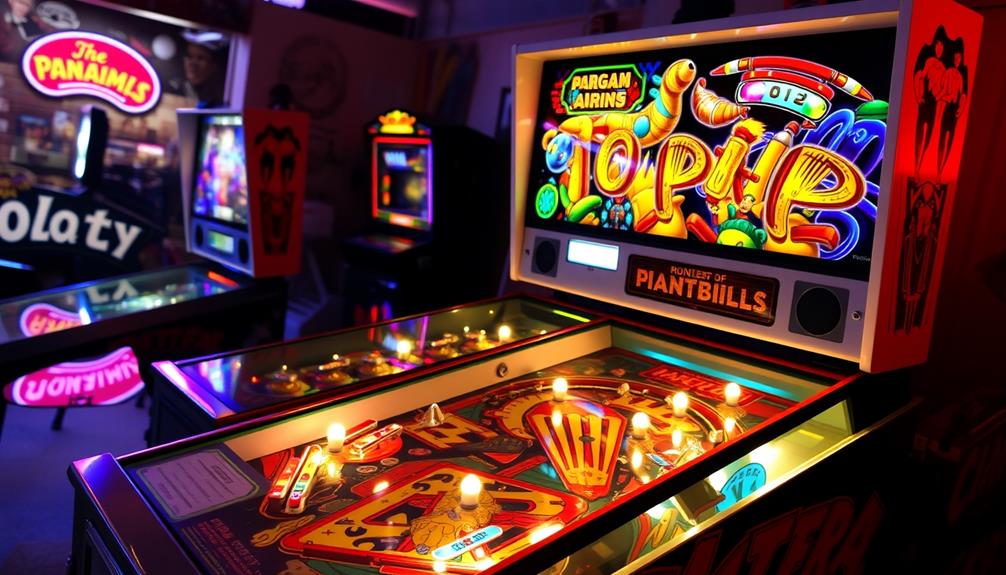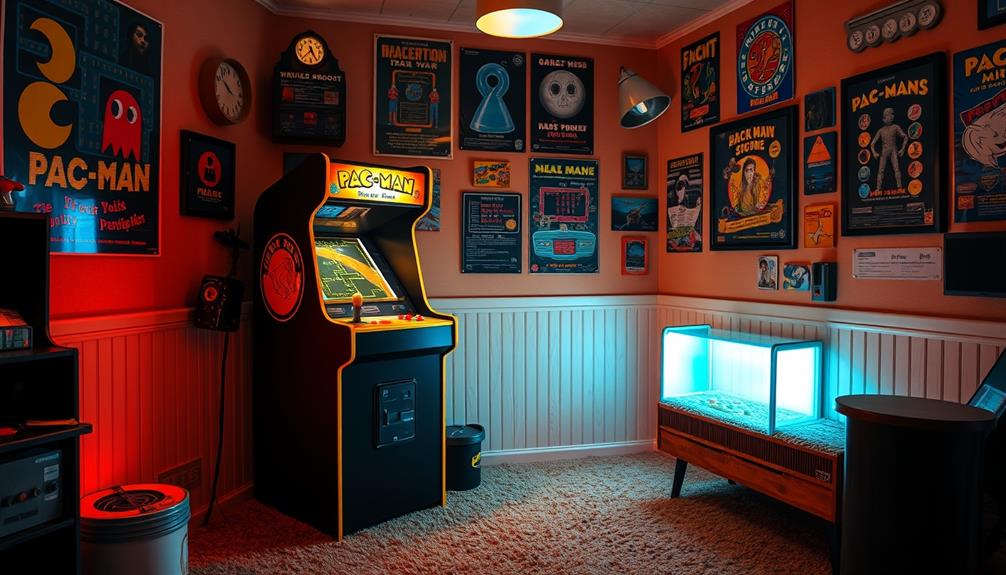Pinball machines were banned in many U.S. cities from the 1930s to the 1970s due to concerns about gambling and ties to organized crime. In 1942, New York City prohibited pinball, seizing thousands of machines over worries about delinquency among young people. This negative view continued for years, influencing public opinion against the game. However, a significant turning point came in 1974 when the California Supreme Court ruled that pinball was a game of skill. This decision led to bans being lifted in cities throughout the late 1970s, signaling a shift in culture that allowed pinball to make a comeback. There is a fascinating story behind this transformation.
Key Takeaways
- Pinball machines became illegal in many U.S. cities during the 1930s due to gambling associations.
- New York City enacted a ban on pinball in 1942 under Mayor Fiorello LaGuardia.
- Significant legal bans on pinball emerged, especially in New York City, throughout the mid-20th century.
- The California Supreme Court ruled pinball a game of skill in 1974, challenging existing bans.
- New York City lifted its pinball ban in 1976 after a demonstration showcased the skill involved in gameplay.
Historical Background of Pinball
The history of pinball is marked by significant legal challenges and societal perceptions that shaped its journey in America. In the 1930s, pinball machines became illegal in many U.S. cities due to their association with gambling. Lacking flippers, these machines were viewed as games of chance rather than skill, sparking widespread concern.
As the popularity of pinball grew, so did the scrutiny, leading to a national debate over its legitimacy as a form of entertainment. By 1942, New York City, led by Mayor Fiorello LaGuardia, enacted a ban, arguing that pinball machines were controlled by organized crime and preyed on vulnerable citizens. Other cities, like Chicago and Boston, followed suit, reflecting a national anxiety about pinball's perceived negative impact on youth and society.
However, the legal landscape began to shift in the 1970s. In 1974, the California Supreme Court ruled pinball a game of skill, establishing a vital precedent that would challenge the existing bans. This pivotal moment set the stage for change across various jurisdictions.
By 1976, New York City lifted its ban on pinball after Roger Sharpe demonstrated the skill involved in gameplay. This shift marked a significant transformation in both public perception and the legal status of pinball, allowing it to reclaim its place in American culture.
The resurgence of pinball also coincided with the introduction of technologically advanced machines, showcasing the evolution of the game and its enduring appeal in arcades and homes alike, as highlighted by the best rated pinball machines of 2024.
Pinball's Legal Bans
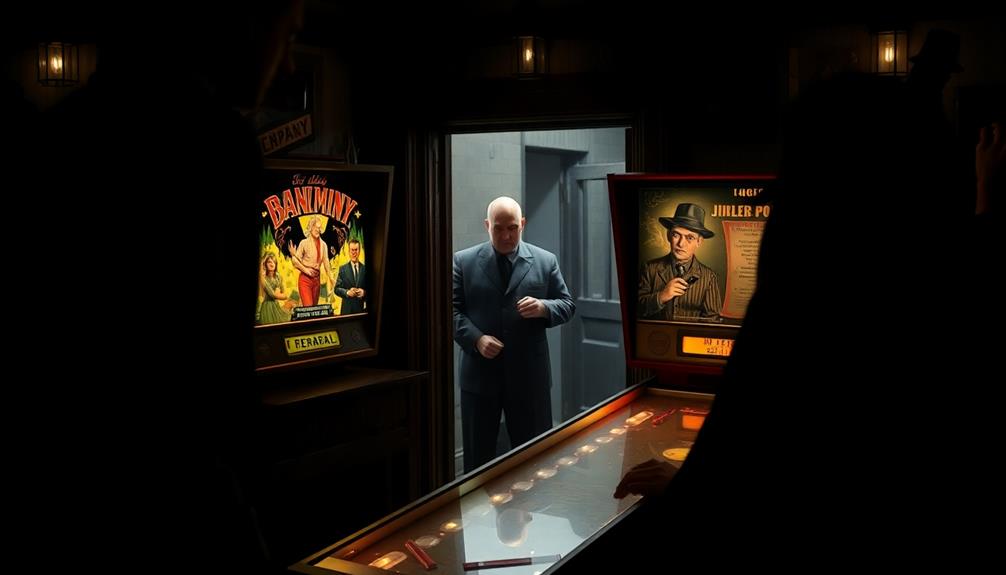
Pinball faced significant legal bans in the mid-20th century, especially under Mayor Fiorello LaGuardia in New York City.
These restrictions arose from a broader societal concern regarding gambling and its association with crime, as officials viewed pinball as a form of gambling that could lead to juvenile delinquency.
The history of pinball machines reveals how these concerns fueled a cultural shift against the game.
Key legal milestones, like the 1974 California Supreme Court ruling, marked turning points that eventually changed pinball's status in society.
Historical Bans Overview
Throughout the mid-20th century, pinball faced a wave of legal bans across major American cities, driven by concerns over its moral implications and potential ties to organized crime. In 1942, New York City, under Mayor Fiorello La Guardia, banned pinball, labeling it a threat linked to gambling and the exploitation of vulnerable citizens, especially during the Great Depression.
This sentiment spread, with cities like Chicago, Boston, and Los Angeles enacting similar bans in the 1930s and 1940s. Authorities believed that pinball machines corrupted youth and exploited the financially vulnerable. This period saw a significant decline in public engagement with pinball, contrasting sharply with its later resurgence as a beloved pastime, supported by innovations in best arcade machines for home game rooms.
To reinforce their stance, public demonstrations were staged, showcasing the destruction of confiscated machines. Thousands of pinball machines met their end in New York City alone, symbolizing the government's crackdown on what they deemed a dangerous pastime.
However, the legal climate began to shift in the 1970s. The tide turned when the California Supreme Court ruled in 1974 that pinball was a game of skill, not chance. This pivotal decision led to the gradual repeal of bans, allowing pinball to reclaim its place in American culture and entertainment.
Key Legal Milestones
Steering through the tumultuous legal landscape of pinball reveals a series of pivotal milestones that reshaped its status in American society. Originally deemed illegal in New York City in 1942 by Mayor Fiorello LaGuardia, who labeled it a gambling racket, this ban led to the confiscation of over 2,000 machines. Other cities, like Chicago and Boston, soon followed suit during the 1930s and 1940s, fueled by fears of gambling and juvenile delinquency.
However, the tide began to turn when the California Supreme Court legalized pinball in Los Angeles on June 22, 1974. This moment marked a significant shift, challenging the earlier bans. In 1976, New York City's council lifted its ban after a demonstration by player Roger Sharpe, who showcased the skill involved in gameplay.
Here's a quick look at key legal milestones:
| Year | Event | Location |
|---|---|---|
| 1942 | Pinball banned | New York City |
| 1974 | Pinball legalized | Los Angeles |
| 1976 | New York City ban lifted | New York City |
| 1970s | Other cities relax restrictions | Across the U.S. |
Cultural Shifts and Impact
As society evolved, perceptions of pinball transformed from viewing it as a dangerous gamble to recognizing it as a legitimate form of entertainment.
Initially, pinball machines faced a ban in New York City in 1942 under Mayor Fiorello LaGuardia, who linked them to organized crime and juvenile delinquency. This ban sparked similar actions in cities like Chicago and Los Angeles throughout the 1930s and 1940s, driven by fears of gambling implications.
Understanding the financial impact of such bans reveals how cultural perceptions can influence economic activities, similar to how budgeting and financial health are vital for personal finance.
Media sensationalism played an important role, framing pinball as a threat to youth and community morals, which fueled public opposition.
However, a cultural shift began in the 1970s as legal challenges emerged. The California Supreme Court's 1974 ruling classified pinball as a game of skill, paving the way for lifting bans.
Public Opposition and Stigmatization

In the 1940s, pinball faced fierce public opposition due to fears of its ties to gambling and youth delinquency.
Leaders like New York City Mayor Fiorello LaGuardia painted it as a danger to children, fueling a widespread belief that it corrupted young minds.
This stigmatization only grew as the media sensationalized its negative associations, pushing pinball further into the shadows.
Moral Concerns and Gambling
Throughout the 1940s, a wave of public opposition surged against pinball, fueled by concerns over its ties to gambling and juvenile delinquency. In cities like New York City, Mayor Fiorello LaGuardia spearheaded an anti-pinball campaign, claiming these machines were mob-controlled gambling rackets that corrupted youth. The media sensationalized this narrative, portraying pinball as a catalyst for crime and delinquency.
| Aspect | Impact |
|---|---|
| Public Sentiment | Negative perception of pinball |
| Government Action | Seizure of over 2,000 machines in NYC |
| Cultural Legacy | Linked to organized crime |
Authorities confiscated thousands of machines, believing it was a moral crusade against gambling. Even with the introduction of skill-based gameplay featuring flippers in 1947, pinball's reputation lingered. The stigma around pinball persisted for decades, as many continued to associate it with illegal gambling activities. Ultimately, these moral concerns shaped how society viewed pinball, turning it from a simple game into a symbol of societal fears around crime and youth behavior.
Youth Delinquency Associations
Fueled by rising concerns about juvenile delinquency, public opposition to pinball intensified in the 1940s. Critics painted pinball as a moral threat, linking it to gambling, organized crime, and financial exploitation of children. This perception led to widespread public outcry, with community leaders rallying against what they deemed a significant factor in youth crime.
The stigma surrounding pinball can be likened to the way trust issues arise in relationships, where communication breakdowns and inconsistency can erode faith in a shared experience. Trust issues with boyfriends may have prompted similar societal reactions to perceived threats against youth.
- Mayor Fiorello LaGuardia spearheaded the anti-pinball campaign.
- Law enforcement claimed pinball operations were tied to organized crime.
- Media sensationalized pinball's association with juvenile delinquency.
- Critics accused the game of exploiting vulnerable youth.
The campaign positioned pinball as a tool for illegal activities, further stigmatizing it in society. As testimonies emerged, the narrative solidified that pinball wasn't just a game—it was a gateway to gambling and delinquency.
The combination of sensational media reports and political activism created a detrimental view of pinball, effectively demonizing it in the eyes of the public. This moral panic ultimately led to the game's prohibition in many areas, showcasing how fear can shape perceptions of youth culture and leisure activities.
The Role of Organized Crime
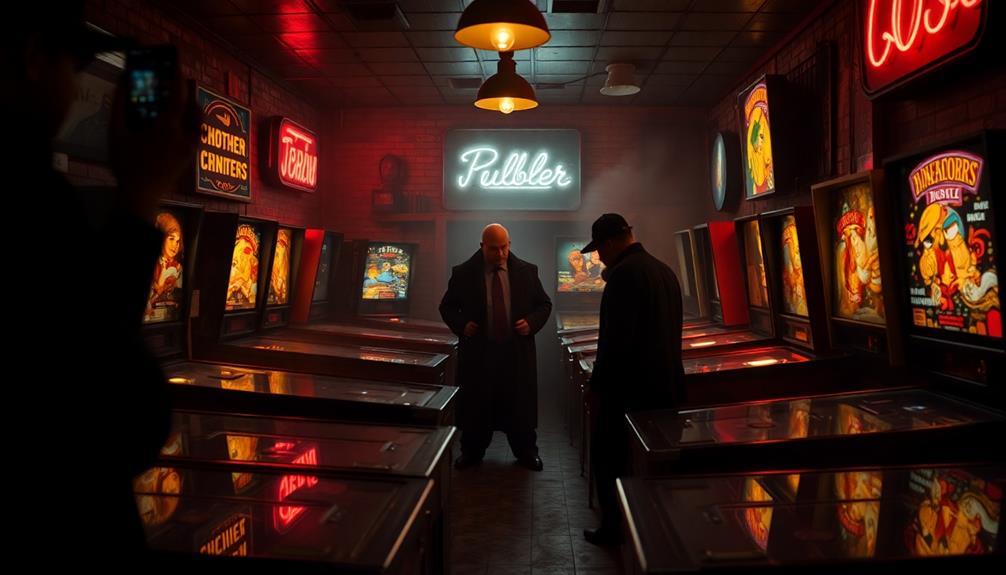
Pinball machines weren't just innocent pastimes in the 1940s; they became notorious tools for organized crime in cities like Chicago. These machines were often linked to illegal gambling operations, acting as fronts for money laundering.
Law enforcement, including the Kings County District Attorney, testified about the connection between pinball and gangs, which fueled public fears and led to legal bans. The incident highlights vulnerabilities in society's perception of entertainment, paralleling concerns seen in cybersecurity measures today. Authorities labeled pinball as a "mob-controlled gambling racket," igniting moral panic across communities.
This perception painted pinball as a corrupting influence on youth, prompting civic groups and law enforcement to advocate for strict bans. The stigma attached to pinball persisted, despite its evolution into a skill-based game with the introduction of flippers in 1947.
Even as players sought enjoyment and skill development, the shadow of organized crime loomed large. The association with illegal gambling made it difficult for pinball to shake off its reputation.
Ultimately, the fear of mob control over this seemingly innocent game led to a significant cultural backlash, shaping how society viewed pinball for decades. It wasn't just about the game; it was about the complex interplay of crime, morality, and youth in a changing America.
Legal Changes in the 1970s
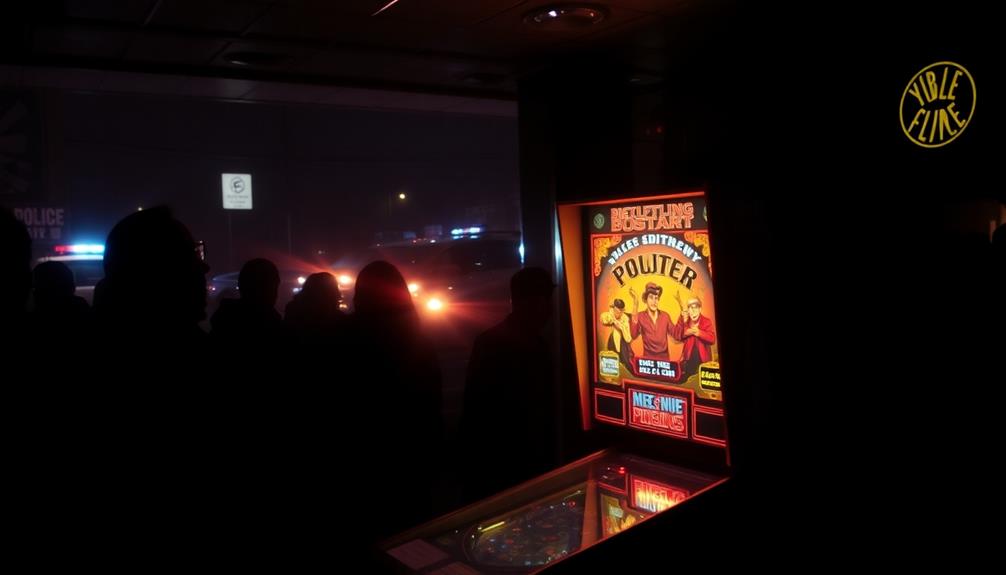
Emerging from the shadows of organized crime, pinball's legal status began to shift dramatically in the 1970s. The pivotal moment came in 1974 when the California Supreme Court ruled that pinball was a game of skill, not chance. This ruling helped overturn existing bans in various cities and resonated with broader discussions about authenticity and existence.
As the decade progressed, cities across the U.S. started reevaluating their stance on pinball, leading to significant legal changes.
In New York City, financial crises prompted discussions about lifting the pinball ban in 1976. Remarkably, skilled player Roger Sharpe demonstrated the game's skill at a city council meeting, which contributed to the repeal of the ban within a month.
By 1977, the Chicago City Council followed suit, reflecting a broader trend of legalization. As more cities relaxed their restrictions on pinball, the following developments became apparent:
- Legal recognition of pinball as a game of skill
- Increased potential for licensing revenue
- The gradual end of pinball bans in major cities
- A shift in public perception towards acceptance
These changes marked a significant turning point in pinball's journey from illegal pastime to a celebrated game.
Cultural Shifts and Acceptance
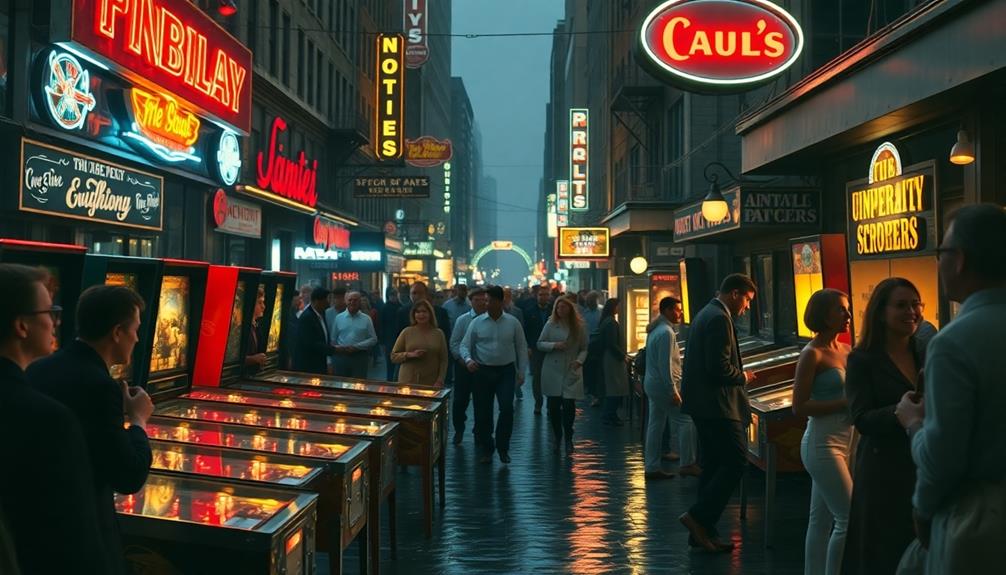
The gradual legalization of pinball in the 1970s set the stage for significant cultural shifts in how society viewed this once-banned game. Initially stigmatized as a moral vice linked to gambling, pinball endured bans in cities like New York City under Mayor Fiorello LaGuardia. However, by the mid-1970s, attitudes began to change as people recognized the skill involved in gameplay.
This transformation is evident in the following table:
| Aspect | Before Legalization |
|---|---|
| Perception | A game of chance, associated with gambling |
| Cultural Acceptance | Viewed as a moral menace |
| Legal Status | Banned in many cities, including NYC |
The landmark ruling by the California Supreme Court in 1974, declaring pinball a game of skill, played a significant role in reshaping public opinion. By 1976, New York City lifted its ban, marking a vital moment in the journey toward acceptance. As pinball evolved from a gambling-related vice to a legitimate form of entertainment, it mirrored broader cultural shifts towards gaming and leisure activities.
The Resurgence of Pinball
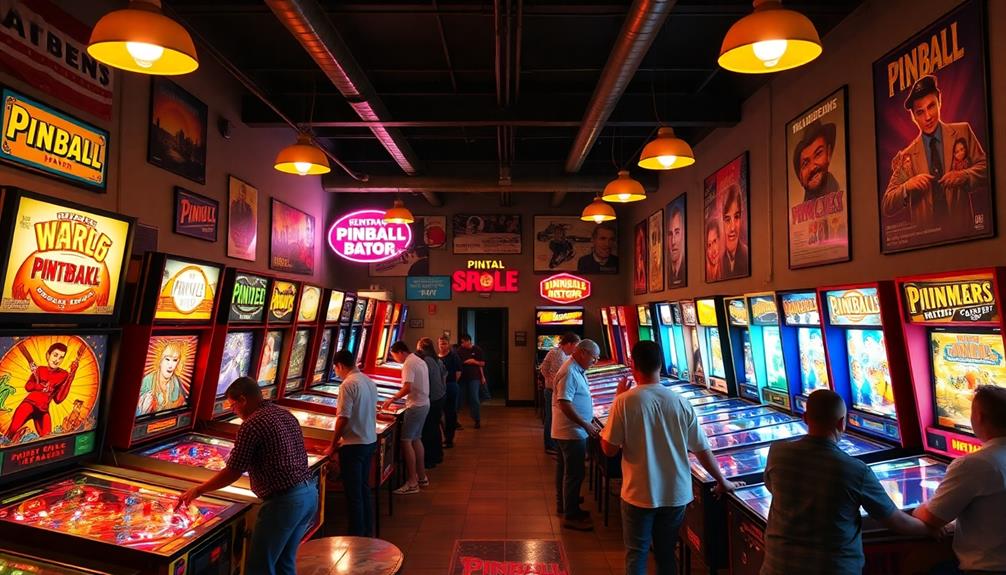
Reviving interest in pinball, enthusiasts have transformed it from a nostalgic pastime into a vibrant community. This resurgence began after key legalizations in the 1970s, particularly following a California Supreme Court ruling that recognized pinball as a game of skill.
With New York City lifting its ban in 1976, pinball evolved from a gambling-associated activity linked to organized crime into an accepted form of entertainment. Additionally, the charm and allure associated with pinball machines can be likened to the star appeal of astrology, as both have the power to captivate and attract individuals.
Today, you can find pinball flourishing in various settings, with passionate players participating in:
- Competitive Tournaments: Over 1,800 events held annually.
- Local Leagues: Communities forming around friendly competition.
- Arcade Revivals: Bars and cafes hosting machines and events.
- Pinball Expos: Gatherings celebrating the culture and history of the game.
This cultural shift reflects a broader appreciation for pinball's intricate mechanics and strategic depth.
Despite the rise of video games in the '80s, the renewed focus on pinball has sparked a dedicated following, fostering a unique blend of nostalgia and modern gaming experiences.
It's a demonstration of how something once deemed illegal can bounce back into the spotlight.
Frequently Asked Questions
Where Is Pinball Still Illegal?
You'll find that pinball remains illegal in Ocean City, New Jersey, on Sundays and in Grove City, Ohio. Some areas still impose restrictions, so check local laws to avoid any surprises.
Why Was There a 35 Year Ban on Pinball?
Pinball faced a 35-year ban due to its association with gambling and organized crime, leading many cities to perceive it as a threat to youth. Public outcry and moral concerns prompted lawmakers to enforce strict regulations against it.
Why Was Pinball Outlawed in California?
You see flashing lights and hear the clinking of coins, yet pinball was outlawed in California due to fears of gambling and crime, with officials deeming it a moral threat to society's youth and values.
Why Was Pinball Illegal in NY?
Pinball was illegal in New York due to concerns about it being a gambling racket. Mayor LaGuardia's campaign targeted it as a threat to morality, particularly for children, leading to confiscation and a lengthy ban.
Conclusion
To sum up, pinball's journey from illegal pastime to beloved game reflects broader societal changes. Did you know that by the 1970s, over 30% of American households had a pinball machine? This resurgence not only highlights the shift in public perception but also emphasizes how we've come to embrace the joy of gaming. Today, you can find pinball in bars, arcades, and homes, proving that this once-banned game has truly earned its place in our culture.
